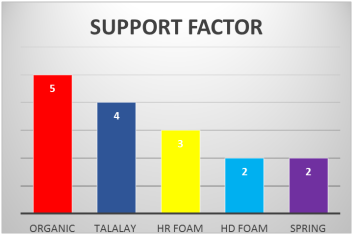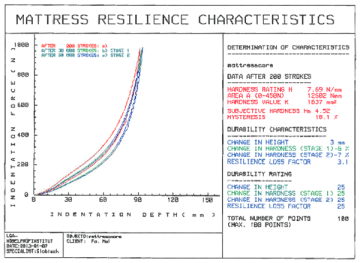Your Cart is Empty
The Science of Sleep

There are certain verifiable scientific measurements that can be used when comparing different mattress materials. The most common metrics used are density, IFD, support factor and resilience. We outline each below and how they relate to organic latex.
Density
Foam density is most commonly measured in pounds per cubic foot (lb/ft3), but the density of organic latex is measured in kilograms per cubic meter (kg/m3). In order to help you compare the density of organic Dunlop latex to other commonly used foams, we have created a conversion chart below.

When examining the density of organic latex, you must take into account the natural variations found within the liquid field latex itself. Since no two natural materials are alike, each piece of organic latex foam will contain slight density variations. These variations happen from top to bottom within a slab and from batch to batch. Although there are ways this can minimized, it’s simply impossible to produce organic latex foam with absolute constancy.
That leads us to the most important aspect of density to consider when discussing organic latex. Unlike synthetic foams, the density of the organic latex is directly related to the firmness of the foam. The higher the density, the firmer the latex. The lower the density, the softer the latex.
IFD
IFD (indentation force deflection) or ILD (indentation load deflection) measures how many pounds of force it takes to compress a piece of foam a percentage of its overall thickness. When analyzing IFD’s, a lower number indicates a softer foam. Although useful as a general guide to firmness, these measurements do have their limitations.
As previously mentioned, the firmness of Dunlop latex is directly related to density. Since the density can vary, there is no such thing as an exact ILD for organic latex. Although these variations are largely imperceptible, no two pieces will be exactly the same. Even the top of a slab will be slightly softer than the bottom. This is because organic latex settles into the mould prior to vulcanization, ensuring the strongest possible natural bonds are created. This is an important step that can’t be bypassed without adding synthetic materials.
When comparing mattresses, rarely will you see latex described by its ILD or density, but rather by the generic terms of soft, medium and firm. These terms represent a range of possible ILD’s. Below is guide to common organic latex densities, their approximate ILD’s and the range of ILD’s often categorized by soft, medium and firm.


The thickness of the foam will also have an impact on the firmness. A thinner sheet of latex will be softer than a thicker slab of the same IFD. Additionally, three 3” layers stacked on top of each other will be softer than one 9” slab of the same IFD. This can also be applied to latex mattresses in general. The thicker the mattress, the softer it will be.
Mattresses made from a variety of layers will not have a specific IFD rating. IFD is a static measurement meant for uniform slabs of foam, whereas mattresses are made from a variety of layers to support a dynamic sleeping environment. Even if you did test each mattress individually, it wouldn’t give a comparable measurement.
Support Factor
Support factor is based off the ratio between the 65% and 25% IFD measurements. Materials with a support factor of three or greater are often referred to as high resilience (HR) foams.
There is a popular misconception that mattresses must be firm to provide any support. Although this is true in some cases, mattresses made from high resilience foams can be both soft and supportive.

The key to organic latex’s high support factor is the variable nature of organic latex polymers. Like snowflakes or fingerprints, no two organic latex polymers are the exact same size or shape. Smaller polymers provide surface comfort by compressing under the weight of your body, while larger polymers provide deep uplifting support by reflecting the weight of your body. The combination of surface comfort and deep uplifting support leads to a more even distribution of your body’s weight over the mattress. This reduces the pressure points that lead to tossing and turning and promotes a deeper, healthier REM sleep.
Resilience
The two most important aspects of resiliency to consider (other than support factor) when analyzing organic latex are responsiveness and durability. Even though highly supportive materials like organic latex greatly reduce the pressure points that lead to tossing and turning, your body still needs to make comfort adjustments throughout the night. Highly responsive, low hysteresis materials like organic latex require very little reaction energy to make these adjustments. By remaining a deep, restorative REM sleep longer, you wake feeling refreshed instead of exhausted from a night spent looking for the perfect sleeping positon.

The second aspect of resiliency to consider is how it relates to the durability of organic latex. Durability can be tested though a process known as dynamic fatigue testing. These tests compress the latex thousands of times to simulate the useful life of a mattress. Independent testers gave our organic latex the highest marks possible when comparing such parameters as height, resilience and firmness loss. In fact, they gave our organic latex a perfect score. Whether it be responsiveness or durability, organic latex leads all other foams in every measurable performance characteristic.
Science vs. Art
The technical aspects of organic latex only tell part of the story. It takes skilled mattress maker, well versed in the intricacies of organic latex, to maximize the inherent support and comfort characteristics of organic latex without using synthetic short cuts. Our vertically integrated, multi-zone construction technique replicates the comfort of Talalay, but with the support, durability and health benefits of organic Dunlop latex.
Gone are the days where you need to be afraid of comfortable. Our expertly designed organic latex mattresses allow you to simply pick the mattress that best fits your needs and the natural wonders of organic latex will take care of the rest.






